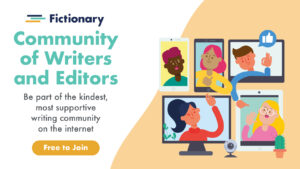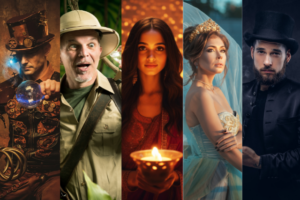
Archetypes are the DNA of storytelling. They provide a universal language that transcends time and culture, connecting us to characters as familiar as an old friend’s embrace. These quintessential patterns, or ideal types, serve as the foundational blueprints for personas that populate tales worldwide. They are the distilled essence of human experience, the roles we recognize and relate to, from the Hero embarking on a quest to the Trickster weaving plots of mayhem.
Archetypes pack a punch that can carry a narrative across the finish line with the power of a thousand galloping horses.
So, saddle up. We’re about to embark on an odyssey through the archetypal landscapes of literature. In this article, we will uncover the archetypes that are the primal blueprints of our personas and characters.
What is an Archetype?
An archetype is like a character template. It represents a universal pattern of human nature.
The concept of archetypes goes way back, with its fingers intertwined in the origins of storytelling itself. The term comes to us from the Ancient Greek words archein (to begin) and typos (type). It was the Swiss psychiatrist Carl Jung who brought the term into modern consciousness. Jung believed these archetypes arise from the collective unconscious.
In literature, archetypes represent the set roles characters play in a story.
What Is a Character Archetype
Character archetypes link stories across time and culture. They bridge the gap between the individual and the universal.
Archetypes serve as the universal benchmarks of human behavior, the distilled essences of themes and personalities that resonate with us on a primal level. They’re the secret sauce that makes stories relishable, and they’re as old as the hills—or at least as old as the art of storytelling itself.
Why Authors Use Archetypes in Their Stories
Authors leverage archetypes to forge an immediate connection with the reader, crafting characters that leap off the page and into our hearts.
From the ancient epic to the latest bestseller, archetypes evoke instant recognition in their audience. Because of this, they provide a shorthand for storytelling, a framework that readers instinctively understand.
But more than this, archetypes are jacking into something bigger. This connection is not just about familiarity; it’s about linking characters to the vast web of human stories that echo through the ages, across cultures and realms. Through archetypes, writers tap into this shared well of human experience.
Authors use archetypes, not just to tell a story, but to evoke the shared stories etched into our very being.
This is especially useful when you’re crafting that ever-so-important external conflict. Archetypes are versatile, reliable, and when used right, they can cut through the toughest narrative conundrums.
Is an Archetype a Cliché?
But wait—is this just fancy talk for what are essentially clichés in a Sunday hat? Not quite.
While archetypes are familiar, they’re not trite. A cliché is a once-fresh idea that’s been left out in the sun too long, whereas an archetype is a vintage wine that only gets better with time.
An archetype is a typical example of a certain person or thing. It’s an original model after which other similar things are patterned.
A cliché, on the other hand, is something that has become so overused it loses its original impact.
While both are recognizable, archetypes serve as the foundation for storytelling, offering writers a framework for creating characters that resonate with universal themes. Clichés are the stale repetitions of that framework, offering little novelty or depth.
Archetypes are about potential and depth, clichés about predictability and surface-level impact.
Do Archetypes Depend on Stereotypes?
Now, don’t get archetypes mixed with stereotypes, either. Even though they do rhyme. Archetypes and stereotypes may be related, but they’re as different as chalk and cheese. Or, to use rhyming words, as distinct as bees and fleas—one buzzes with the rich nectar of universal themes, while the other merely irritates with its superficial bite.
Stereotypes are archetypes gone rogue. They’re oversimplified and distorted caricatures. The truth is, archetypes are the very antithesis of stereotypes. Whereas archetypes are foundational patterns upon which we build, stereotypes are a carving away; a simplification of complex groups.
And now that we’ve covered what archetypes are and are not, let’s look at some of the most common archetypes, exploring both their characteristics and some examples.
What Are the Archetypes?
There are 20+ archetypes, but here are the 11 most common ones.
The Lover Archetype

Characteristics of the Lover Archetype
Ah, the Lover—the eternal embodiment of passion and desire. These characters are all heart and soul, driven by the power of love in its myriad forms. Whether it’s the profound love for another person, a burning passion for a cause, or an unending quest for beauty and harmony, they are the ones with roses in hand and hearts worn unabashedly on their sleeves.
Their presence in a story serves as a reminder of the universal quest for connection and the lengths to which we’ll go to protect and preserve the objects of our affection. They are the heartbeat of many narratives, pumping the lifeblood of emotion and human connection through the veins of the plot.
Examples of the Lover Archetype
Romeo and Juliet, Elizabeth Bennett, and even Edward Cullen—these are the folks who’d walk through fire for love, and often do.
The Trickster Archetype

Characteristics of the Trickster Archetype
The Trickster is the wildcard, the agent of change, often cloaked in mischief. Tricksters challenge the status quo, poking at society’s soft underbelly with a pointy stick of irony and wit.
In their essence, Tricksters are the embodiment of the unexpected. They bring motion to stagnation, inject humor into solemnity, and introduce doubt into certainty. They remind us that life is not always to be taken so seriously and that sometimes, breaking the rules is the only way to truly understand them.
Examples of the Trickster Archetype
From Loki, the Norse god of mischief, to the Cheshire Cat of Wonderland, Tricksters remind us that life is not always as serious as it seems.
The Hero Archetype

Characteristics of the Hero Archetype
The Hero is the backbone of countless narratives, the one who answers the call to adventure. Bravery, sacrifice, and growth are the hallmarks of this archetype.
Often, the Hero in a story is against a ticking clock—they must save the day by a particular deadline or event. The “ticking clock” is an example of an archetypal conflict. It is the building block for many sorts of conflicts a protagonist can face.
Examples of the Hero Archetype
Think Katniss Everdeen fighting against the Capitol or Harry Potter facing off against Voldemort. These heroes embody our deepest desires for courage and triumph.
The Outlaw Archetype

Characteristics of the Outlaw Archetype
Outlaws don’t just break the rules—they rewrite them. This archetype is the rebel with a cause, often standing in opposition to societal norms. The Outlaw is a celebration of the maverick spirit. Outlaws are the rule-breakers and the system-shakers, the ones who stand defiantly in the face of convention and refuse to be bound by the chains of societal expectations.
Outlaws are driven by a deep-seated desire to upend what they see as unjust or corrupt. They challenge, they provoke, they dare to ask “Why?” when the world demands “Because.” They become inadvertent champions for those who lack the power to challenge the status quo. In their resistance, the Outlaw frequently clashes with the larger forces of their world, a classic example of “character vs. society” conflict that drives so many compelling narratives.
Examples of the Outlaw Archetype
From Hans Solo to Captain Jack Sparrow, these characters personify the allure of the Outlaw archetype—they’re proof that sometimes, to quote a bit of pirate philosophy, “the code is more what you’d call ‘guidelines’ than actual rules.”
The Caregiver Archetype
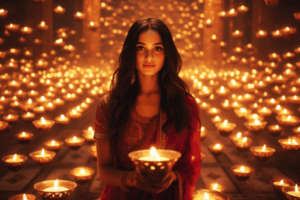
Characteristics of the Caregiver Archetype
The Caregiver archetype embodies the spirit of nurturing and support. It serves as the emotional anchor in both the tumultuous seas and calm waters of the narrative. Caregivers are the ones with an open door, a warm embrace, and a listening ear at any hour—yes, even at three in the morning, when the shadows of the world loom large and threatening. They embody empathy and compassion.
Examples of the Caregiver Archetype
Hagrid with his gentle giant heart and Molly Weasley with her fierce maternal instincts are classic examples.
The Ruler Archetype

Characteristics of the Ruler Archetype
The Ruler archetype is the embodiment of authority, control, and governance. These are the characters who hold the reins of power, whether seated on a grand throne in a sprawling palace or wielding influence from the shadows of a corporate boardroom. Rulers are adorned with crowns—either real or metaphorical, a symbol of their status as decision-makers.
Examples of the Ruler Archetype
King Arthur, with his legendary round table, showcases the Ruler’s capacity for leadership and wisdom.
The Sage Archetype (or Mystic Archetype)
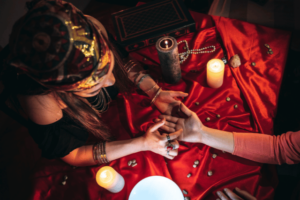
Characteristics of the Sage Archetype
The Sage embodies wisdom and knowledge. These characters serve as the guiding light for protagonists, and often provide crucial knowledge at pivotal moments. They are marked by profound insight, calm demeanor, and an oftentimes uncanny understanding of the world around them. Think of them as the wise old mentors whose counsel is as valuable as any magical talisman.
Examples of the Sage Archetype
From Merlin to Yoda to Gandolf, Sages are the repositories of wisdom that guide heroes through their darkest hours and most perplexing dilemmas.
The Magician Archetype

Characteristics of the Magician Archetype
Magicians are the alchemists of the character world, transforming reality through knowledge and will. They are the innovators and the visionaries, often using their power to push the boundaries of what’s possible. Magicians are charismatic and influential, presenting a deep understanding of the forces that govern the world, both seen and unseen.
Examples of the Magician Archetype
Prospero from Shakespeare’s “The Tempest” is a quintessential Magician, wielding his sorcery to shape events to his will, while Doctor Strange from the Marvel Universe uses his mystical arts to protect reality itself.
The Explorer Archetype

Characteristics of the Explorer Archetype
Explorers are the wanderers who crave adventure and discovery above all else. They are driven by curiosity and a desire to experience new things. These characters are always pushing the envelope, setting off into the unknown in pursuit of truth.
Examples of the Explorer Archetype
Indiana Jones, with his iconic hat and whip, searches for ancient artifacts, while Star Trek’s Captain James T. Kirk boldly goes where no one has gone before, exemplifying the Explorer’s quest for knowledge and new horizons.
The Villain Archetype
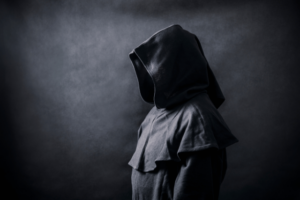
Characteristics of the Villain Archetype
The Villain is the shadow to the hero’s light, often serving as the primary antagonist in a story. They are characterized by their malevolence and their opposition to the protagonist’s goals. Villains can be power-hungry tyrants, cold-hearted monsters, or charismatic antiheroes.
Villains appear most often when a story features a Character vs Character type of conflict. This is the sort of conflict in which the protagonist (often a Hero archetype) faces an obstacle to their story goal in the form of another character.
Examples of the Villain Archetype
Literature gives us Voldemort, the dark wizard of the “Harry Potter” series, and the power-driven Lady Macbeth, whose ambitions lead to tragedy.
The Seeker Archetype
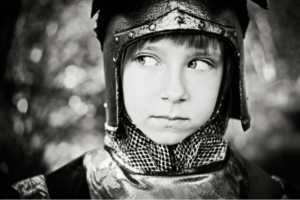
Characteristics of the Seeker Archetype
Seekers are the eternal questioners on an endless quest for truth and fulfillment. They are never content with easy answers and are always probing deeper, pushing the limits of their understanding. Their journey is as much internal as it is external.
Examples of the Seeker Archetype
Elizabeth Bennet from “Pride and Prejudice” seeks a life beyond the societal expectations of marriage, while Frodo Baggins in “The Lord of the Rings” seeks both to destroy the One Ring and find his place in a world much bigger than he ever imagined.
Archetype Definition: Conclusion
As we’ve explored the archetypes of literature, we’ve uncovered the timeless blueprints that shape our stories and characters. These archetypes, from the Hero to the Trickster, from the Lover to the Outlaw, remind us that, no matter the genre—be it fantasy, sci-fi, romance, or historical fiction—our narratives share the same universal threads of desire, conflict, and aspiration.
Now, imagine a place where this deep appreciation for archetypes, characters, and storytelling all comes together. A community where writers of all genres can come together to share, learn, and grow.
Fictionary is that haven. It’s the kindest author community on the internet, where the love for storytelling shines through in every discussion, critique, and piece of advice shared among peers.


